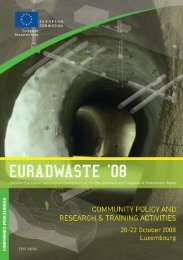EU industrial structure - EU Bookshop - Europa
EU industrial structure - EU Bookshop - Europa
EU industrial structure - EU Bookshop - Europa
Create successful ePaper yourself
Turn your PDF publications into a flip-book with our unique Google optimized e-Paper software.
<strong>EU</strong> <strong>industrial</strong> <strong>structure</strong> 2011 — Trends and Performance<br />
FIgURE III.3: <strong>EU</strong> average annual production growth rate in 1995-2010 (%)<br />
Optical instruments and photographic eq.<br />
Air and spacecraft and related machinery<br />
Irradiation, electromedical and electrotherapeutic equipment<br />
Medical and dental instruments<br />
Motor vehicles<br />
Forging, pressing, stamping and roll<br />
Installation of <strong>industrial</strong> machinery and equipment<br />
Parts and accessories for motor vehicles<br />
Instruments and appliances for measuring<br />
General purpose machinery<br />
Processing and preserving of sh<br />
Soap and detergents<br />
Agricultural and forestry machinery<br />
Basic chemicals<br />
Pulp, paper and paperboard<br />
Bakery and farinaceous products<br />
Processing and preserving of meat<br />
Electric motors<br />
Vegetable and animal oils<br />
Grain mill products<br />
Wiring<br />
Other chemical products<br />
Processing and preserving of fruit<br />
Treatment and coating of metals<br />
Other food products<br />
Batteries and accumulators<br />
Sawmilling<br />
Other electrical equipment<br />
Cement, lime and plaster<br />
Concrete, cement and plaster<br />
Refractory products<br />
Wood, cork, straw and plaiting materials<br />
Tanning and dressing of leather<br />
Tanks, reservoirs and containers of metal<br />
Domestic appliances<br />
Ships and boats<br />
Other textiles<br />
Transport equipment n.e.c.<br />
Man-made bres<br />
Clay building materials<br />
Computers and peripheral equipment<br />
Other porcelain and ceramic products<br />
Finishing of textiles<br />
Weaving of textiles<br />
Clothing<br />
Knitted and crocheted clothing<br />
Preparation and spinning of textile<br />
Musical instruments<br />
Footwear<br />
Magnetic and optical media<br />
-10 -8 -6 -4 -2 0 2 4 6<br />
Note: The figure only shows the 25 high and low (negative) growth sextors.<br />
Source: own calculations using Eurostat data.<br />
III.2 Sectoral competitiveness<br />
indicators<br />
Competitiveness is a multidimensional concept, which<br />
is studied from two perspectives in this report. The first<br />
perspective looks at means for industries to improve their<br />
competitiveness by lowering their costs, increasing their<br />
productivity, employing skilled labour, renewing their<br />
capital stock and increasing their spending on R&D and<br />
innovation to upgrade their products. Different indicators<br />
which measure aspects of an industry’s competitiveness,<br />
such as labour productivity and unit labour costs (ULC),<br />
are the subject of the remainder of this chapter. The<br />
second perspective studies how effective industries<br />
have been in improving their competitiveness in the<br />
international markets. This perspective is analysed in<br />
Chapter V.<br />
60<br />
This section presents a set of indicators on <strong>EU</strong> sectoral<br />
growth, productivity, unit labour costs and relative prices.<br />
The objective is to present stylised facts across the main<br />
sectors of the economy and to show the role of labour<br />
productivity in sectoral competitiveness. More precisely,<br />
market services are sub‑divided into two groups. The<br />
first consists of wholesale and retail trade, repair of<br />
motor vehicles, motorcycles and personal and household<br />
goods, hotels and restaurants, transport, storage and<br />
communication (NACE Rev. 1 categories G to I) and the<br />
second comprises financial intermediation, real estate,<br />
renting and business activities (NACE Rev. 1 categories J<br />
and K). Non‑market services encompass public<br />
administration and defence, compulsory social security;<br />
education; health and social work; other community, social<br />
and personal service activities; private households with<br />
employed persons (NACE Rev. 1 categories L to P). Industry
















